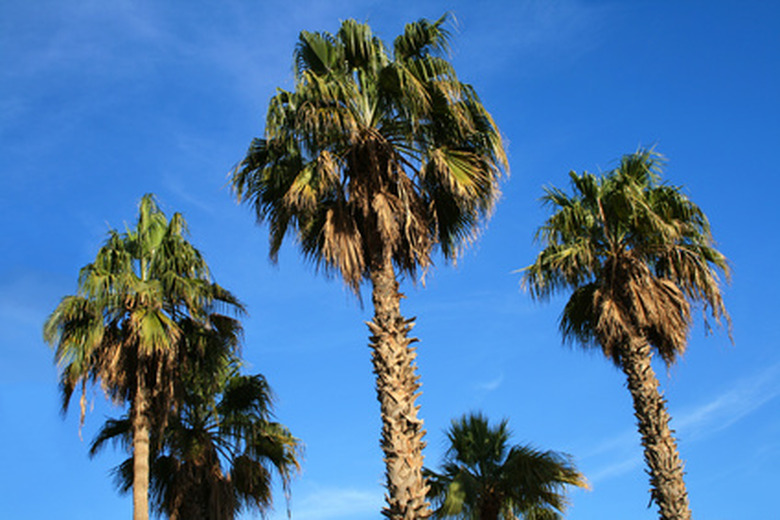Sabal Palm Tree Facts
The sabal palm (Sabal palmetto), commonly called the "cabbage palm," grows on a large, single trunk that towers up to 50 feet in height and may reach 70 feet under ideal conditions. The crown, comprised of fronds, measures 18 feet in diameter. The fronds appear medium green or yellow-green in color. Each individual frond measures 12 feet in length, with a 6 foot width.
Foliage Growth
The fronds on the sabal palm have no crown shaft, according to Floridata. The fronds each grow directly from the trunk. Along the trunk of the base, the leaf bases remain to give a criss-cross pattern that often reaches to the ground. On areas of the tree that have no leaf bases, the trunk appears a fibrous brown. As the tree ages, the areas become smooth and gray in color.
- The sabal palm (Sabal palmetto), commonly called the "cabbage palm," grows on a large, single trunk that towers up to 50 feet in height and may reach 70 feet under ideal conditions.
- On areas of the tree that have no leaf bases, the trunk appears a fibrous brown.
Leaf Base
Within the base of the leaves that have shed, debris accumulates over time and offers the ideal area for ferns to growth. Many other organic life forms call these debris-rich areas home. Landscape sabal palms often have orchids or resurrection ferns planted within their inviting depth as natural planters.
Flowering
In mid-summer, within the crown of the sabal palm, creamy-white inflorescence appear in abundance. Each flower stalk measures up to 4 to 5 feet according to the U.S. Forest Service. As each flower cluster reaches it maximum length, it begins to droop and give the appearance of large, white feathers.
Fruit Production
In the fall, black, round fruit appear on the sabal palm. Each fruit measures around 1 inch in diameter. Within each fruit is a single seed. The fruit is widely popular among birds, squirrels and raccoons as a source of food.
- Within the base of the leaves that have shed, debris accumulates over time and offers the ideal area for ferns to growth.
- In mid-summer, within the crown of the sabal palm, creamy-white inflorescence appear in abundance.
Seedlings
Seedlings accumulate in abundance around the base the sabal palm. They easily transplant to new locations. Young sabal trees benefit from being staked to help them tolerate strong winds.
Planting Location
The sabal palm thrives in full or partial sunlight. It is salt tolerant and will withstand brackish water conditions. The tree offers drought tolerance, once established, and can withstand regions that are sandy and dry. The tree is popular for beach-side plantings in Florida. When first planted, the tree requires ample water to survive due to its shallow root system.
- Seedlings accumulate in abundance around the base the sabal palm.
- The sabal palm thrives in full or partial sunlight.
